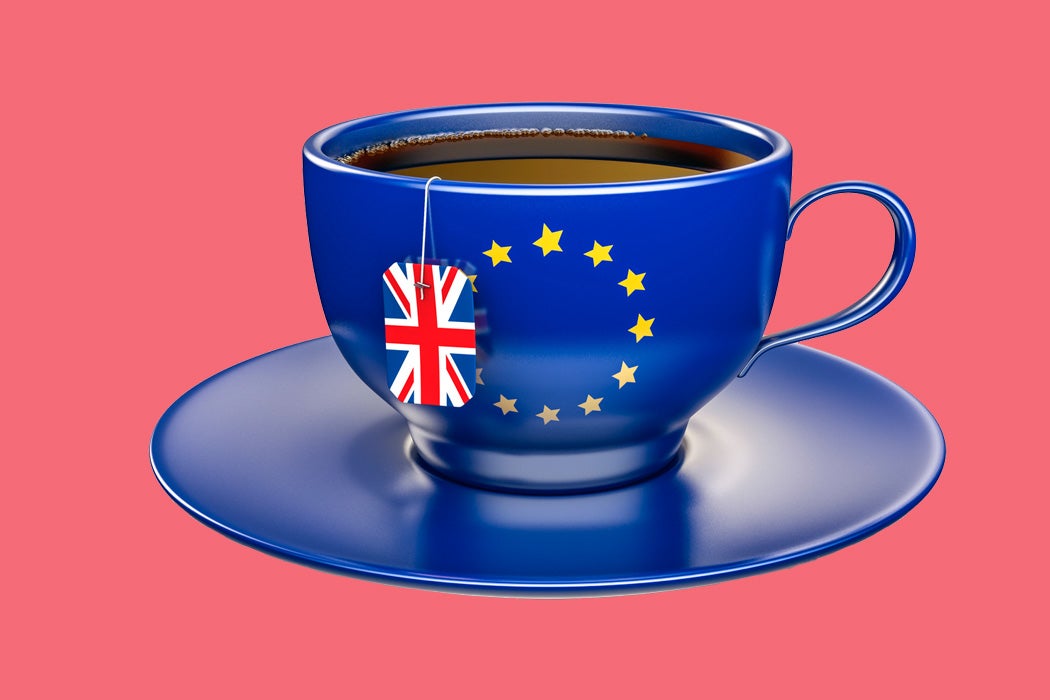Brexit has inspired far more metaphors than it has solutions. Every politician, pundit, and pub bore has come up with their own way to describe the British vote to leave the European Union. Brexit is apparently like leaving a golf club, escaping from prison, eating a chocolate orange, flying to the moon, playing football, ordering at a restaurant, taking an egg out of an omelette, or paying a bar bill.
Audio brought to you by curio.io
Tea analogies are particularly popular. James Acaster, a comedian, compared Brexit to making a cup of peppermint tea:
If you leave the bag in, then over time the cup of tea itself as a whole gets stronger. And it might appear like the bag is getting weaker but it’s now part of a stronger cup of tea. Whereas, if you take the bag out, the tea’s now quite weak and the bag itself goes directly in the bin.
Perhaps the only person not to deploy a tactical analogy is Theresa May, who began her campaign to become Prime Minister by saying “Brexit means Brexit.” The tautology helped her win the support of Conservative MPs back in 2016, perhaps because the meaningless phrase was a blank canvas for them to fill in with their own views. It offered no satisfaction, though, to the people who asked, “But what does Brexit mean?”
As the PM considers how to find support for her wildly unpopular Brexit deal, she may wonder if she would have been better off with a few well-chosen metaphors to explain her vision. Are the analogies simply gusts of whimsy? Or do they reveal a deeper issue? If the British cannot agree about how to describe Brexit, how can they ever hope to resolve it?
* * *
Brexit is a multi-metaphored beast because it is complicated. It bears no obvious resemblance to any other political situation in modern history. Metaphors, as the political scientist Murray Edelman wrote, “are devices for simplifying and giving meaning to complex and bewildering sets of observations that evoke concern.”
Yet politicians do not merely explain; they also persuade, and for some time philosophers, psychologists, and political scientists have been trying to understand how metaphors can be used to change minds. Flashy analogies may grab people’s attention, but their simplicity also invites rebuttal. When John Redwood, a pro-Brexit MP, compared being in the EU to being a university student, saying, “when you depart you have no further financial obligations,” it was inevitably challenged. Anyone using a metaphor risks having it thrown back in their face.
So how might metaphors be persuasive? The focus for scholars has been on analogies which are less explicit, something usually described as “conceptual metaphor,” or as “dead” or “root” metaphor, which is barely seen as figurative. George Lakoff, a cognitive linguist who has written extensively in the field, puts it this way:
We think in metaphor. A large proportion of our most commonplace thoughts make use of an extensive, but unconscious, system of metaphorical concepts… Because so much of our social and political reasoning makes use of this system of metaphorical concepts, any adequate appreciation of even the most mundane social and political thought requires an understanding of this system. But unless one knows that the system exists, one may miss it altogether and be mystified by its effects.
If political debate is framed by metaphor, then politicians and other political actors should be able to define the terms of debate, allowing them to limit or shift the conversation. Lakoff’s 1995 paper for Social Research, “Metaphor, Morality, and Politics, Or, Why Conservatives Have Left Liberals in the Dust,” suggests that conservative Americans have a more coherent unconscious metaphorical structure for their moral and political world view than liberals do. It is, he says, based on moral strength centered around the family. Liberals, by contrast, have a similar foundation, yet their metaphorical framework is split. They do not understand the rhetoric that underpins conservatism, so cannot argue against it effectively.

It’s an idea similar to the Overton Window, a generally untested concept developed by the libertarian think tank executive Joseph P. Overton, one that gained a lot of currency during Donald Trump’s presidential campaign. Overton held that there is a range of acceptable discourse, and by debating matters on the edge of acceptability and normalizing them, it is possible for politicians to shift public opinion. Trump apparently did this by raising subjects at the extremes of political debate. Metaphor could be part of the mechanism of moving the window, if it exists.
* * *
If there was one area of debate that shifted significantly to enable the vote to leave the EU, it was immigration. The Leave campaigns put great emphasis on migration to the UK from inside the EU, with freedom of movement of people a major campaign topic. Yet in 2001, the Conservative manifesto did not mention immigration at all and there was barely any mention of the word “asylum,” according to the linguist Jonathan Charteris-Black. By 2003, it had been adopted as an issue and in 2005 played a significant part in the general election campaign, one that the Conservatives ultimately lost.
Charteris-Black points out the other compelling persuasive element to metaphors—their ability to evoke emotion, “to resonate with underlying symbolic representations, to stir emotions and bridge the gap between the logical and emotional.” He discovered that the far-right British National Party often used the word “immigrants” and spoke in terms of natural disasters—swamped, limitless flow, tidal wave and flood—whereas the Conservatives at the time used only “immigration” and favored container metaphors—full up, secure borders, open the gates, and pressure. Ultimately, the Conservatives lost the election and their opponents criticised the campaign as racist.
The use of natural disaster metaphors became more mainstream in the eleven years leading up to the 2016 poll. In 2015, David Cameron spoke of a “swarm” of migrants trying to reach Britain, but critics did not describe his comments as racist. During the campaign, Nigel Farage’s grassroots Leave campaign created a famous poster of a column of men walking along a road captioned “Breaking Point” —an expression taken from the “natural disasters” category of metaphors with a high emotional impact.
If the natural disasters metaphor became more prevalent during the referendum campaign, perhaps other forms of potentially persuasive root metaphors became embedded in political discourse. Five years before the referendum, Brexiteers—then known as Euroskeptics—were a fringe group who argued that leaving the EU meant what is now called a “soft Brexit:” remaining within the single market and staying close economically to the rest of Europe. Now that idea is described by mainstream politicians as a “betrayal.”
The most obvious candidate for a persuasive root metaphor is the word Brexit itself. The portmanteau of British Exit has become an entirely natural part of discourse, yet the concept of exiting the EU is metaphorical. It creates the idea that Britain can stop being an EU member state by walking through a door or out of a building. The metaphorical framework of “exit” invites ideas like escaping prison, entering sunlit uplands, and so on—all of which are simple, easy, and quick. And during the process, Britain can be a purposeful, unified whole, unchanged by the act of going through the exit.

The concept of exit was given an official stamp by Theresa May, who created the Department for Exiting the EU, and many of the concepts about the political debate form around words like departure and leaving, which are not recognised as metaphors. Even the ballot paper itself asked voters if they wanted to leave or remain.
An alternative framework, preferred by the President of the European Commission, Jean-Claude Juncker, works around separation. The separation framework, which leads to the idea of a “Brexit divorce” and from there to a “divorce bill,” was contested during the early phase of the negotiations between the UK and twenty seven other EU member states when some Leave-supporting MPs disputed that the UK should pay any money to the EU after Brexit day. Since the British government agreed to pay a sum of around £39billion to “settle the accounts,” contributing to projects that are already underway as the UK agreed, the concept of divorce seems less uncomfortable. By repetition, it has become a more natural part of language.
Now, since Theresa May negotiated a withdrawal agreement with the EU, a further metaphorical framework has emerged: Brexit as online shopping. Brexit is something to be “delivered” and the deal that the Prime Minister negotiated is not what the British people voted for. The focus on delivery carries with it a sense that Brexit is an object that can be returned, an attractive idea for remain-inclined campaigners, such as the People’s Vote, as well as Brexiteers.
* * *
The persuasive power of metaphor has a ring of truth to it, but empirical evidence to support it is harder to come by. In fact, there is a suggestion that intense language or images can create a “boomerang effect.” The obvious attempt to persuade can make the receiver more skeptical. Perhaps this is why the lyrical analogies for Brexit have not ultimately shifted opinion very much.
Various researchers have tried to study metaphor in an experimental context, but according to a literature review by the psychologist Jeffery Scott Mio, the results have been mixed or contradictory. It is possible that hidden metaphors are no more persuasive than many researchers believe subliminal advertising to be.
Still, the lure of metaphor as a mechanism for mass persuasion persists, and governments have begun studying it systematically. In 2011, the Intelligence Advanced Research Projects Activity, a U.S. intelligence agency, started the Metaphor Program, “to exploit the use of metaphors by different cultures to gain insight into their cultural norms.”
Get Our Newsletter
The agency had a particular focus on Russian and Farsi and was interested in developing “automated tools” to mine for metaphors in large tracts of text. The agency said in a briefing to potential partners that it was trying to find an alternative to surveys:
Responses may suffer from conscious or unconscious interference (e.g., respondent is trying to please the questioner). Persons may refuse to participate, which can result in sample bias. Populations may be illiterate and may not be familiar with surveys, which can also prejudice the results.
The result was the Metaphor Detection System, which researchers have used to examine metaphors quantitatively, with studies focused on examining whether metaphors develop in a pattern around a particular event or if concepts can be applied across languages.
To date, no one appears to have used the Metaphor Detection System, or any other type of machine learning system, to examine the Brexit debate. But whatever methods politicians are using to settle the debate have not worked so far. Whether or not politicians can manipulate or persuade their voters through metaphors, the future of Britain involves resolving the Brexit argument. Perhaps taking time to agree exactly what Brexit is and what it means would be a start.







